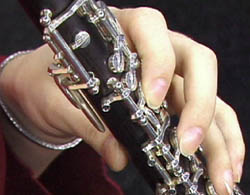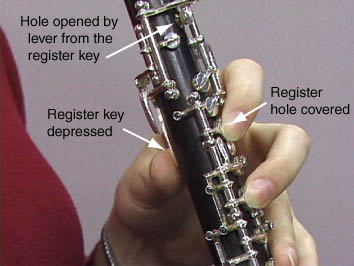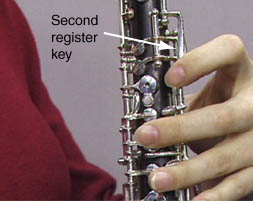The Upper Register of the Oboe
Since the oboe has the form of a conical air column, it will produce the same fundamental frequency as an open cylinder of the same length and will also produce all harmonics. The first upper register is then an octave above the fundamental (the second harmonic) for a given length of air column.
|
The upper register is achieved by opening a hole in the side of the air column close to the mouthpiece. Opening a hole releases excess air pressure and destroys the fundamental vibrational mode. If properly positioned, the hole favors the second harmonic mode which has a pressure node (displacement antinode) in the region near the mouthpiece. Achieving the upper register with the oboe is complicated by the fact that the optimum placement for the hole differs significantly for different ranges of the instrument. Higher notes in the lower register of the instrument require opening holes along the column to shorten it. This means that the hole for achieving the higher register for that note should be closer to the mouthpiece. In fact, each note of the lower register would have a different optimum position for the register hole, but this is not practical. As an operational compromise, the design of the oboe incorporates three different holes for achieving the upper register. |
 |
 Lower register |  Upper register |
| Video example of register change |
The first of these holes is in the form of a key with a hole in it which is kept covered with a finger of the left hand when playing notes in the lower register. For the lower notes of the fundamental register, the upper register can be achieved by lifting the finger from this hole as demonstrated above.
 Register key action |
For notes higher in the fundamental register, corresponding to shorter overall column lengths, a hole closer to the mouthpiece is needed to induce the jump to the upper register. This is achieved by a register key which uses a lever to lift a pad to open the needed hole. |
 Second register key For still higher notes, a second register key is used in addition to the first register key. By a rather complicated compound lever action, it closes the previous register hole and opens one still closer to the mouthpiece to excite the second harmonic of the shorter conical column. |
 |
Thanks to Liz McKeown for helping to demonstrate the instrument.
Woodwind instruments
Musical instruments
| HyperPhysics***** Sound | R Nave |